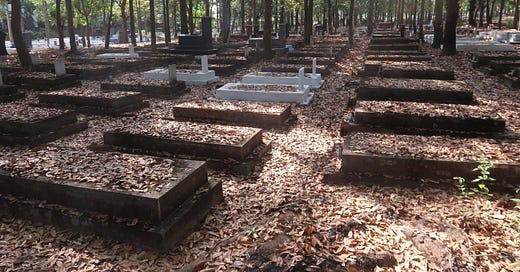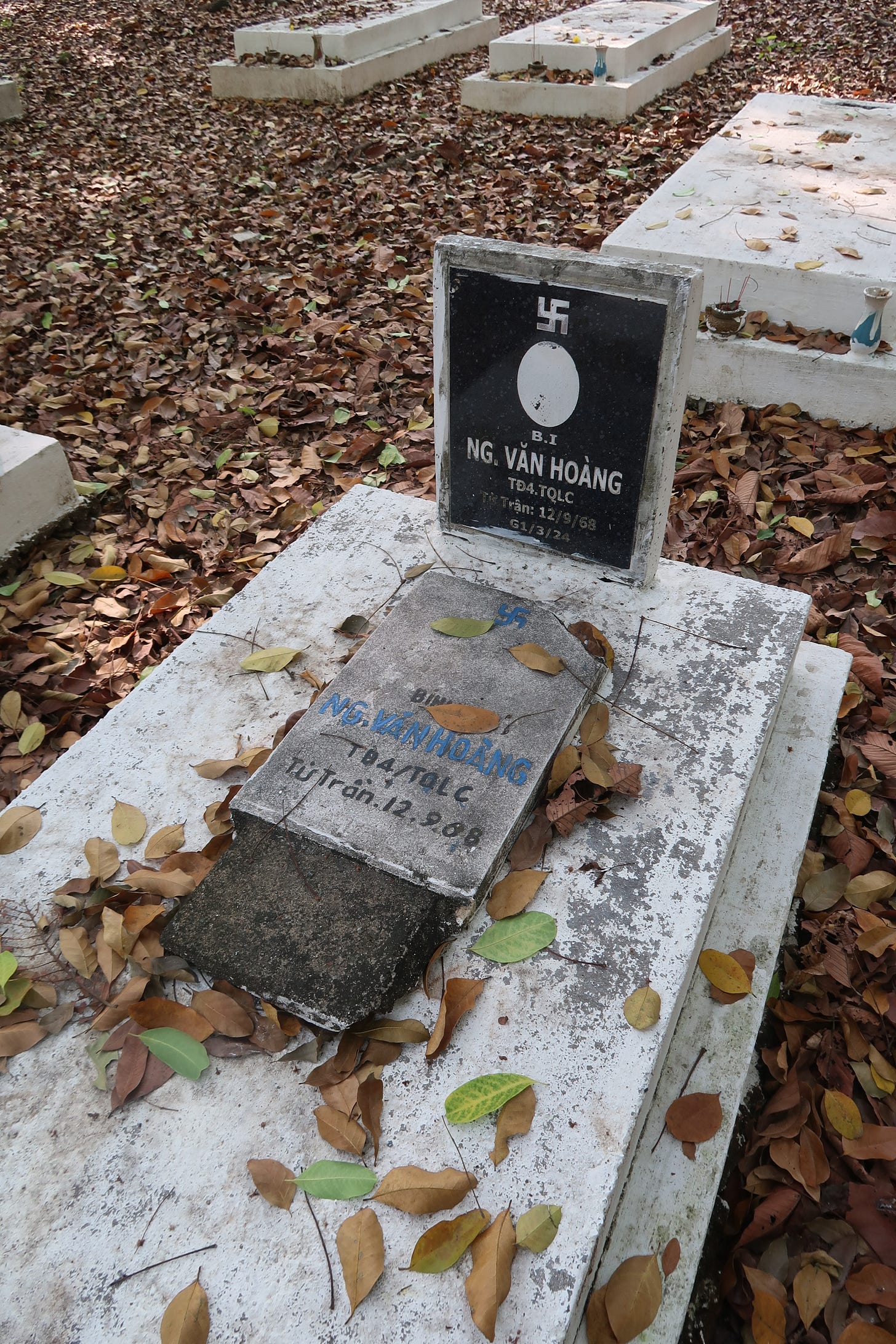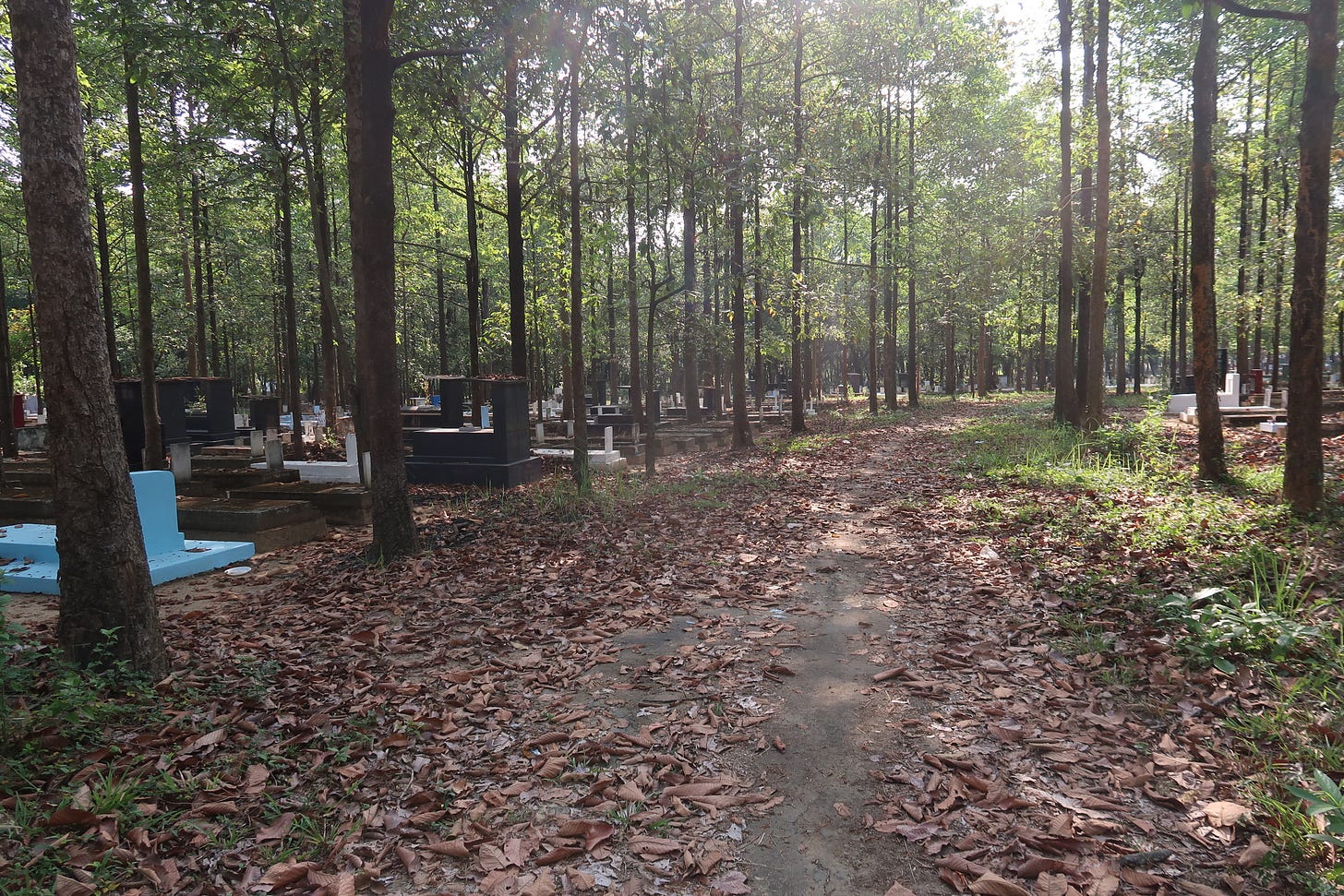Once known as the Bien Hoa Military Cemetery - Nghĩa trang Quân Đội Biên Hòa, in Vietnamese - 15 kms northeast of Saigon (today’s Ho Chi Minh City) is one of the most poignant remnants of the Vietnam War which ended 50 years ago next month. The nearly 60-hectare site was once the Republic of Vietnam or South Vietnam’s own Arlington Cemetery to honour and bury its own war dead, all up an estimated 200-250,000 military on the Saigon side from the 20 year conflict that ended in 1975.
The ‘weary soldier’ statue was created by Vietnamese sculptor Nguyen Thanh Thu and stood at the entrance of the vast Bien Hoa Military Cemetery on the highway to Bien Hoa with the pavilion in the background and the obelisk beyond and graves in circles around it.
With its entrance off the US-built Bien Hoa Highway marked by the sad statue - and such a typical image of the time - of a sitting ARVN soldier with an M1 rifle across his knees and popularly known as Thương Tiếc (weary soldier), the 60-hectare site beyond was cut by a ceremonial road to a hilltop pagoda and then beyond to graves in circles around a huge obelisk. Opened in 1966, some 18,000 South Vietnamese military were buried in the cemetery by the war’s end in 1975.
And so what to do with this cemetery for what the winning communist-led regime in Hanoi and its southern supporters had always called “puppet troops” of the Americans, “lackeys and traitors?” The living were sent to communist re-education camps. Others escaped as Boat People. Saigon’s famous colonial-era Mac Dinh Chi Cemetery where the French and South Vietnamese elite were buried was razed for a park and southern Vietnam’s first satellite link to the world. Ordinary cemeteries too. Martyr cemeteries to the winning side’s dead sprang up all over the old South and visible everywhere today.
The pavilion remains the most publicly visible part of what’s now called the Binh An Cemetery.
And a pleasant walk up rickety old steps into a quite bare interior with a small altar for incense.
Somehow, the Cemetery survived but was closed to the world. Along the highway, now dubbed the Hanoi Highway, second-hand construction equipment dealers opened shop followed by huge export factories hiding the hilltop pavilion. Unused parts of the circular cemetery were increasingly encroached upon by other businesses.
Other industrial buildings, shops and residences popped up along a road skirting past pavilion and on the cemetery’s left, now hidden from view by a cement-rendered brick wall with only a military-style entry and checkpoint. Along here, a rather sad and run-down Buddhist temple is a more fitting intruder.
I don’t have any inside information on what the government’s thinking was about the cemetery’s future. Nor do I know personally of the feelings and struggles of the families of the dead soldiers wishing to pay their respects inside the cemetery which descended into ruin - and a state of limbo.
“Let’s turn Saigon into Stalingrad,” former South Vietnamese Vice President Nguyen Cao Ky was saying the weekend before Saigon fell on 30 April 1975. But it was all too late, of course.
Finally, the cemetery became a personal mission of former South Vietnamese Vice President Nguyen Cao Ky who’d first come to public prominence as the flashy & glamorous VNAF (air force) Air Marshall following the last of the many coups that followed the overthrow and assassination of President Ngo Dinh Diem in November 1963. In ‘75, he’d called on Saigonese to turn the city into a Stalingrad and then escaped like so many other southern leaders ending up in Southern California.
To much controversy in the refugee community, the northern-born Ky and his family returned to Vietnam in January 2004 and was given permission by his communist hosts to visit the Bien Hoa Cemetery. At a minimum, he argued publicly, the cemetery should be opened to family members to pay their respects.
I still vividly recall Nguyen Cao Ky’s crashing the farewell dinner of our five-yearly Saigon War Correspondents Reunion back in April 2005. He’d heard we’d all be at the old Maxim restaurant on Dong Khoi (formerly Tu Do & Catinat) down near the Majestic Hotel on the Saigon River - and started by an old Third Force friend of mine, Ly Qui Chung, whom you’ll hear more about in excerpts from my memoir.
He casually took up a booth on the side of our gathering in the middle of the room. And then, sure enough. “Say, isn’t that Nguyen Cao Ky over there?” a former colleague blurted out. He knew we’d be there and set it all up.
And once everyone said hello and took pictures and finally settled down, Ky revealed why he was he was there and asked us a favour. “Could some of you come with me to the Bien Hoa Cemetery tomorrow?” he asked. The government had promised they’d open it up for the families but hadn’t come through, he explained. Ky wanted to bring a few of us old journos along to put some pressure on.
But nobody was all that game, especially as our reunion was not officially sanctioned. Plus, I was taking a tour north to Hanoi early the next day. Not sure if that’d worked in any case, but the cemetery was finally opened up to families - and the public - the following year in 2006.
It’s been a while since my last visit with an old colleague back in 2009 and felt fortunate just getting past suspicious officials at the gate. We wrote our names into a notebook and sternly warned not to take any photos, although I did shoot a few. The entire atmosphere was sad and oppressive, many of the graves neglected and headstones broken. Some graves lay open after families had obviously decided to move the bodies elsewhere. I wasn’t in a hurry to return.
But with next month’s 50th Anniversary of the Fall of Saigon coming up - and some spare time before returning to Australia next week - I thought I’d be worth checking out what’s happened to South Vietnam’s Arlington Cemetery. (And just getting out there and finding the cemetery on a motorbike is worth an entirely separate post! I can hardly believe I’m still doing that at 81 years old.) Perhaps it’d make a worthwhile story for all those journos showing up for the 50th might find this a good story suggestion. (And if the government allows ‘em!)
Clear evidence the cemetery is open and family spending money with many modern additions like these to the once simple and uniform headstones & graves as in the background.
And so it was quite a pleasant surprise driving through the gate today and very kindly greeted by the officer on the gate - no questions, nothing - and asked to fill in a form with my name, nationality and address. “And do I need to walk,” I asked? No, just use your motorbike, he replied waving me into the vast tree-shrouded cemetery with the pathways all covered in fallen leaves, always unusual in the tropics.
I drove up first to the cemetery’s imposing obelisk - or what’s left of what was once covered in glowing tiles - to find well-maintained and watered gardens of flowers and a couple workers. And then into the heart of the cemetery, parking and getting off for a wander and taking pictures.
The graves closest to the centre date from battles of late 1968 and then through 1974 as I worked my way outwards to recall those depressing post Paris Cease-fire Agreement days as South Vietnam fought and died all on its own. Nothing from those fast-moving last days from March to end of April 1975 and those who never received a ceremonial burial.
But what heartened me most about visiting the cemetery today was seeing how the previous uniformity of the graves, basically simple headstone and cement, has been disrupted by the refurbishment of many of them by the dead men’s present-day families. Wherever they’ve come from, the great Vietnamese Diaspora or right here in Vietnam, they are keeping the memory of their lost one alive. I was very touched.
Here’s keeping an eye on you! That surveillance camera above the cemetery’s simple altar.
And then after my wanderings, I was back at the Obelisk in front of an altar and, wouldn’t you know, there’s a surveillance camera right overhead. Hmmm. I wonder who’s watching me? And everyone else too.
But what the heck, let’s watch me light three sticks of incense - which took a while in the breeze - and then pray to the memory of all these poor souls and all the other two million or so Vietnamese, military & civilian, of both sides who died in that stupid Vietnam War. Bless them.












